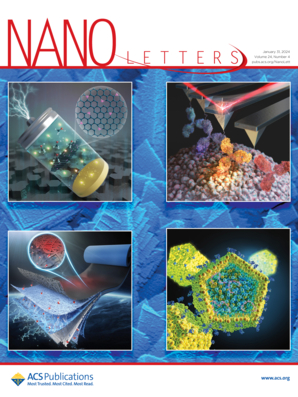Oxamate Nanoparticles for Enhanced Tumor Immunotherapy through Blocking Glycolysis Metabolism and Inducing Pyroptosis
IF 9.6
1区 材料科学
Q1 CHEMISTRY, MULTIDISCIPLINARY
引用次数: 0
Abstract
Tumor metabolic reprogramming, particularly the Warburg effect, is crucial for rapid tumor growth and immune evasion. Lactate dehydrogenase A (LDHA), a key enzyme in tumor aerobic glycolysis, is overexpressed in tumors and is considered an effective therapeutic target. Sodium oxamate (SOM) is a classic LDHA inhibitor, but its poor cell permeability, low tumor killing effect, and ineffective immune activation limit its application. Herein, SOM nanoparticles (NPs) were prepared via a thin-film hydration method for amplified cancer immunotherapy. SOM NPs are efficiently taken up by tumor cells through endocytosis, releasing NH2COCOO– and Na+ ions, which cause osmotic pressure and oxidative stress, activating pyroptosis and immunogenic cell death (ICD) to initiate the immune response. Simultaneously, NH2COCOO– blocks glycolysis of tumor cells, resulting in inhibiting the proliferation, migration, and invasion and alleviating immunosuppression. This work will facilitate the application of SOM in tumor therapy and provide a new paradigm for glycolytic metabolism and pyroptosis-mediated tumor treatment.

通过阻断糖酵解代谢和诱导焦亡增强肿瘤免疫治疗的草酸酯纳米颗粒
肿瘤代谢重编程,特别是Warburg效应,是肿瘤快速生长和免疫逃避的关键。乳酸脱氢酶A (LDHA)是肿瘤有氧糖酵解的关键酶,在肿瘤中过表达,被认为是有效的治疗靶点。草酸钠(SOM)是一种经典的LDHA抑制剂,但其细胞渗透性差、肿瘤杀伤效果低、免疫激活效果不佳等特点限制了其应用。本文采用薄膜水合法制备了SOM纳米颗粒(NPs),用于肿瘤放大免疫治疗。SOM NPs通过内吞作用被肿瘤细胞有效吸收,释放nh2coco -和Na+离子,引起渗透压和氧化应激,激活焦亡和免疫原性细胞死亡(immunogenic cell death, ICD),启动免疫应答。同时,NH2COCOO -阻断肿瘤细胞的糖酵解,抑制肿瘤细胞的增殖、迁移和侵袭,减轻免疫抑制。这项工作将促进SOM在肿瘤治疗中的应用,为糖酵解代谢和热解法介导的肿瘤治疗提供新的范式。
本文章由计算机程序翻译,如有差异,请以英文原文为准。
求助全文
约1分钟内获得全文
求助全文
来源期刊

Nano Letters
工程技术-材料科学:综合
CiteScore
16.80
自引率
2.80%
发文量
1182
审稿时长
1.4 months
期刊介绍:
Nano Letters serves as a dynamic platform for promptly disseminating original results in fundamental, applied, and emerging research across all facets of nanoscience and nanotechnology. A pivotal criterion for inclusion within Nano Letters is the convergence of at least two different areas or disciplines, ensuring a rich interdisciplinary scope. The journal is dedicated to fostering exploration in diverse areas, including:
- Experimental and theoretical findings on physical, chemical, and biological phenomena at the nanoscale
- Synthesis, characterization, and processing of organic, inorganic, polymer, and hybrid nanomaterials through physical, chemical, and biological methodologies
- Modeling and simulation of synthetic, assembly, and interaction processes
- Realization of integrated nanostructures and nano-engineered devices exhibiting advanced performance
- Applications of nanoscale materials in living and environmental systems
Nano Letters is committed to advancing and showcasing groundbreaking research that intersects various domains, fostering innovation and collaboration in the ever-evolving field of nanoscience and nanotechnology.
 求助内容:
求助内容: 应助结果提醒方式:
应助结果提醒方式:


